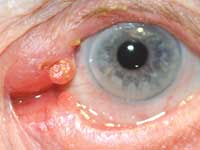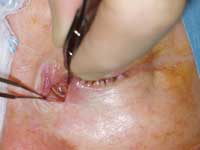Minimize punctum plug complications by proper patient, design choice
Complications from the use of punctum plugs to treat aqueous insufficiency are fairly uncommon; however, adverse events can be minimized by selecting the appropriate patient and choosing specific plug configurations.
Complications may include epiphora, foreign body sensation, infection, pyogenic granuloma, dislodgment, washout, punctal canalicular erosion, dacryocystitis and increased allergy symptoms.
Foreign body sensation
“As a general rule, the most common complication is foreign body sensation, representing about 60% of all complications,” Scot Morris, OD, FAAO, in private practice in Conifer, Colo., told Primary Care Optometry News in an interview. “This sensation is typically caused by the plug not being seated correctly. An edge is showing, which rubs on the surface of the eye.”
Two options are either to reposition the plug or to insert a different punctum plug that does not touch the surface.
Excessive tearing
Epiphora usually constitutes the second most frequent complication. “One of the biggest problems with punctal occlusion is that plugs are put in for the wrong reasons.” Dr. Morris said. “You may be treating the wrong type of dry eye, which will result in complications, because that part of the tear film was previously working fine. But by plugging it up, the tear film is now worse.
“It is not uncommon for the patient to experience epiphora the first day or so,” Dr. Morris continued. “However, it should not last long term. If so, the best solution is probably to remove the plug. Somewhere along the line, the practitioner made a wrong judgment.”
|
Image: Daily R
Image: Mauriello J |
Treating infection
For treating infections related to a punctum plug, antibiotics are recommended. “For example, using a fourth-generation fluoroquinolone will normally take care of an infection such as dacryocystitis,” Thomas D. Gilbert, OD, FAAO, a regional clinical director for TLC Laser Eye Centers, based in Columbus, Ohio, told PCON.
According to Charles B. Slonim, MD, FACS, an oculoplastic surgeon in Tampa, Fla., dacryocystitis, a tear sac infection, may require lacrimal surgery. Performing a dacryocystorhinostomy (DCR) consists of bypassing the natural tear canal (nasolacrimal duct). “You go directly from the lacrimal sac to the nose,” Dr. Slonim said in an interview.
Pyogenic granuloma can often be treated by removing the plug. “If the tissue is not inflamed, no further treatment is needed,” Dr. Gilbert said.
Dislodged, washed out plugs
If dislodgment occurs within 48 hours of plug placement, “it usually means that the punctum was overdilated,” Dr. Morris said. However, in cases were dislodgment happens after 48 hours, “you probably used the wrong size plug.”
This can be remedied by inserting the next larger size plug.
Proper size selection of a plug is important, Dr. Gilbert agreed. “You want the plug to be snug, but not too tight,” he said. “I believe you get more complications when the plug is not the proper size for the patient’s punctum. I also like capped plugs that ride on the top of the lid of the puncta, so that it can be removed with jeweler’s forceps, if necessary. A capped plug is also visible with a slit-lamp examination, so I know if the patient has lost the plug or not.”
“Washout” occurs when the plug lodges further down the drainage system. “A punctal dye test will tell you if you have drainage,” Dr. Morris said. “However, this is not a very specific test because the dye can enter either the upper drainage system or the lower drainage system.”
Irrigation is the preferred method to determine flow, he said.
Patients with washout, but without epiphora or infection, can have their plug remain, according to Dr. Morris.
Erosion, allergy
The first step in the treatment of punctal canalicular erosion is removal of the existing plug. “Use of a topical steroid or fourth-generation fluoroquinolone is advised,” Dr. Morris said. “In most instances, the erosion will heal on its own. However, in rare instances, sutures may be required and recannulization issues must be reviewed.”
Another potential complication of punctum plugs is an increase in symptoms of allergy. “Although plugs help increase the wetness of the eye and decrease the symptoms associated with dryness, they also may increase the allergic symptoms,” Dr. Slonim said. “When you put a plug in the tear duct and block the outflow of the natural tearing system, you also trap the inflammatory mediators on the surface of the eye. This includes pollens. So, you can exacerbate an allergic or inflammatory reaction.”
Lodged plugs
Dr. Morris has been successful correcting a plug via irrigation or probing. If irrigation/probing fails, the only solution is a DCR, “whereby a plastic surgeon slits through the canaliculus and finds the plug,” he said.
Removing a stuck plug “is very difficult,” Dr. Slonim said. “Most of these plugs are not radio-opaque, so they do not show up on an X-ray.”
Passing a probe, on the other hand, may help identify the blockage. “You can surgically cut down on the plug by going directly over the top of the plug if it is in the canalicular system,” Dr. Slonim said. “Once the plug is removed, a piece of silicone tubing is placed in the tear duct during the healing process, “so the tear duct will not close or scar down.”
Practitioners use proparacaine topical anesthetic drugs when probing. Dr. Gilbert added that he also uses a topical antibiotic drop.
Dr. Slonim’s success rate in removing a lodged plug varies, depending on the location. “You hope that once the plug is removed, you are not going to have chronic problems associated with the plug having been in that position,” he said. “Overall, I’ve been very successful in removing plugs, but the surgery is rarely easy, especially with the intracanalicular plugs.”
Choosing plug design
When choosing between an intracanalicular plug and a true punctum plug, Dr. Morris prefers the latter, because once an intracanalicular plug is lodged further down the drainage system, “it is really difficult to tell if it is even in or out,” he said.
Some plugs, specfically the intracanalicular plugs, are problematic, according to Dr. Slonim. “These plugs are supposed to be easily flushed out,” he said. “However, many of us find a high incidence of nasolacrimal duct obstruction as a result of the plug being passed into the nasolacrimal duct, yet the plug stays there and does not pass all the way through the system. Hence, the plug creates its own blockage. When anything blocks the tear duct past the lacrimal sac, the lacrimal sac can gather bacteria found in the tears and cause an infection in the sac (a dacryocystitis).”
As a member of the American Society of Ophthalmic Plastic and Reconstructive Surgery (ASOPRS), Dr. Slonim and others have shared a number of “lacrimal disasters” involving intracanalicular plug complications. “We’ve had enough complications with intracanalicular plugs to highly recommend that they never be used.” Dr. Slonim said. “We feel there are much better plug choices. Punctal plugs (non-intracanalicular) are easier to remove if you want to reverse the process,” Dr. Slonim said.
For more information:
- Scot Morris, OD, FAAO, can be reached at Eye Consultants of Colorado, 10791 Kitty Dr., Ste. B, Conifer, CO 80433; (303) 250-0376; fax (303) 816-7218; e-mail: smorris@eyeconsultantsofco.com.
- Thomas D. Gilbert, OD, FAAO, is a regional clinical director for TLC Laser Eye Centers. He can be reached at 8415 Pulsar Place, Ste. 120, Columbus, OH 43240; (614) 431-8079; fax (614) 430-9388; e-mail: tom.gilbert@tlcvision.com.
- Charles B. Slonim, MD, FACS, can be reached at 4444 E. Fletcher Ave., Ste. D, Tampa, FL 33613; (813) 971-9709; fax (813) 977-2611; e-mail: slonim@eyelids.net.


